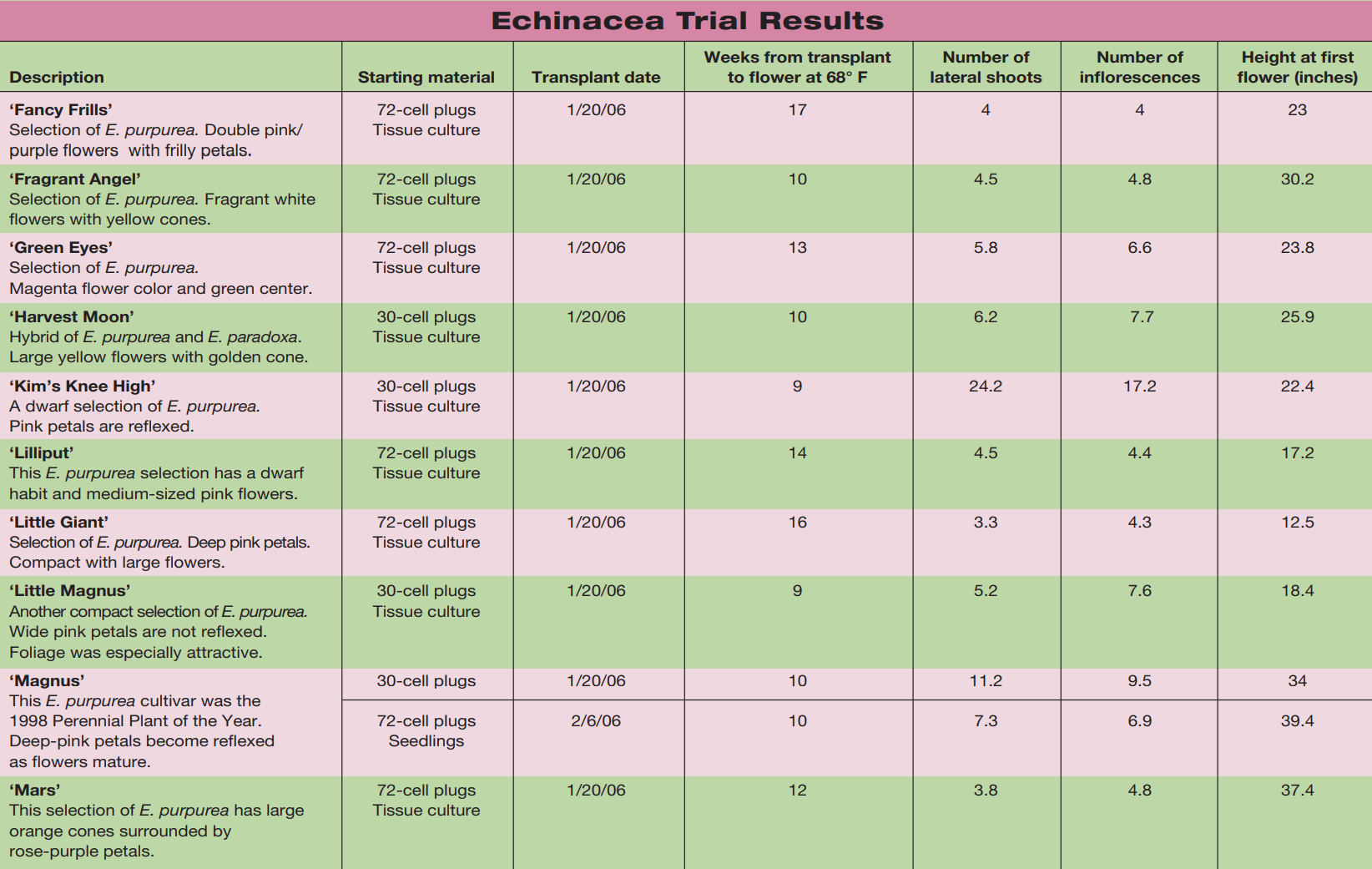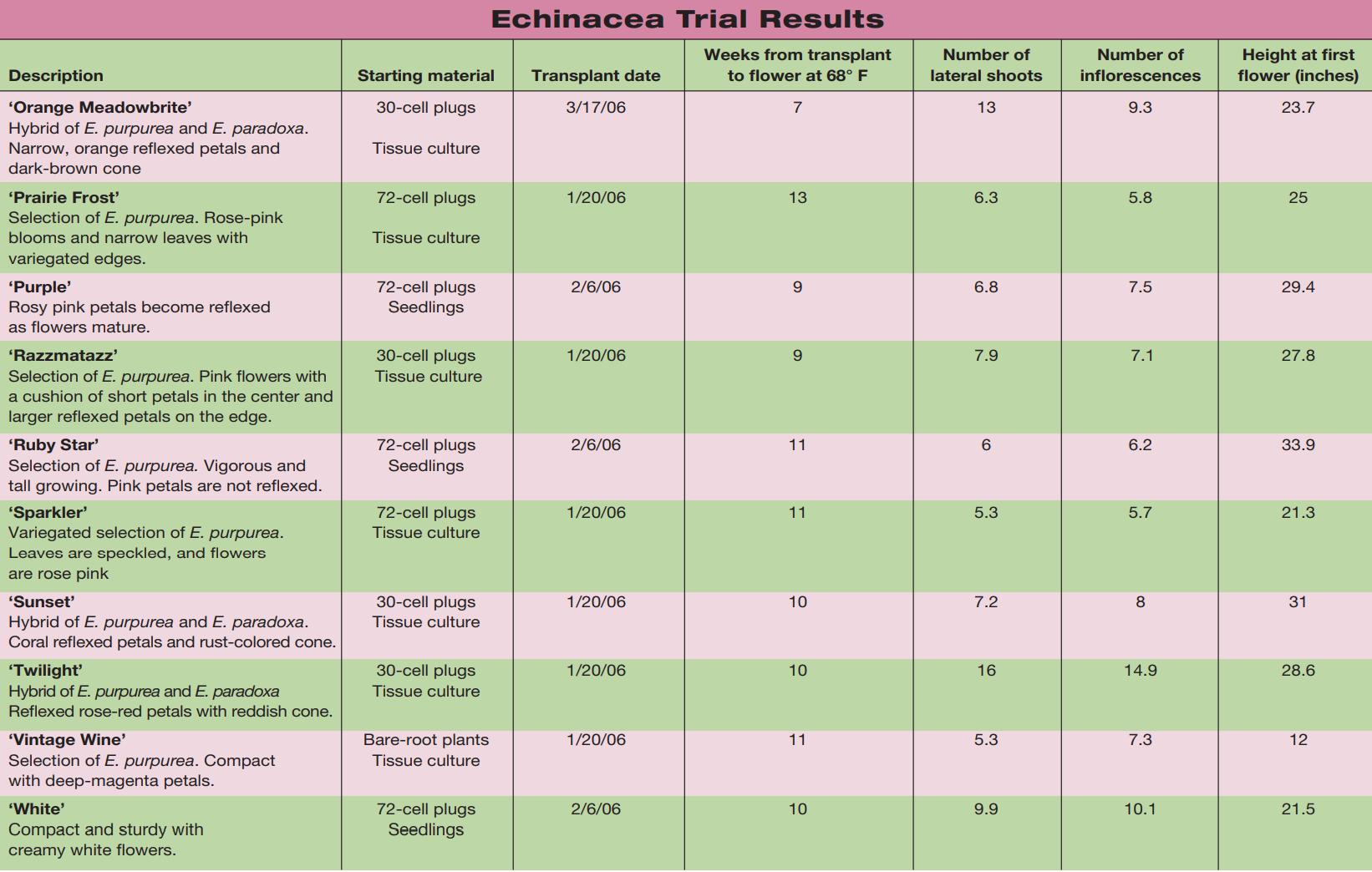
Evaluating new Echinacea cultivars
DOWNLOADJune 29, 2007 - Cathy Whitman, Sonali Padhye, Arthur Cameron, Erik Runkle, and Nate DuRussel
Evaluating new Echinacea cultivars
Echinacea, commonly known as coneflower, is a North American genus of nine species in the asteraceae family. Echinacea was one of the primary medicinal herbs used by many tribes of North American Plains Indians and, subsequently, by the early settlers. Thanks to a recent resurgence in popularity among herbalists, there has been a dramatic increase in its use in North America and Europe. The genus has become the object of extensive research to identify the bioactive chemicals and determine their effectiveness. E. purpurea is one of the three species that have possible pharmacological activity and is being cultivated in growing numbers to supply a booming market.
Increasing Cultivar Choices
Several echinacea species hybridize readily in the wild, which has complicated their taxonomy but been a boon to breeders. Multiple crosses between various members of the genus have yielded some very exciting results in the past five years. Hybrids of E. purpurea and the yellow-flowered E. paradoxa have transformed the market with yellow, orange, coral, salmon and rose-pink flowers. In addition, numerous selections of white or pink-to-purple-flowered. E. purpurea with compact habits, double flowers or variegated leaves have been released recently. New cultivars also offer variations in petal length and width, degree of doubleness, reflexed (drooping) or not reflexed petals, and center cone colors.
In 2004, we began to research the newly released echinacea ‘Sunrise’ that has soft, buttery yellow petals. These plants did not require cold for flowering but did require long days to produce attractive plants in a reasonable amount of time. Our 72-cell plugs bloomed in about 13-14 weeks when grown under 16-hour long days at 68° F. Plants were vigorous and handsome, reaching about 30-35 inches in height at flower.
Objectives And Methods
Since many of the new echinacea cultivars are recent introductions, little is known about their greenhouse performance and cropping time. We expanded our trials to study an assortment of the new echinacea cultivars. We wanted to test their potential as potted flowering crops and compare their performance by growing them in a common environment. The garden performance and winter hardiness of select echinacea cultivars in Michigan is also being evaluated.


Echinacea cultivars were received in January and February 2006 as a variety of starting materials ranging from small seedlings to tissue-culture 72-cell and 30-cell plugs to field-grown divisions. Most were dormant upon arrival. Plants were transplanted into 51 ⁄2-inch pots containing a peat and perlite mix and immediately placed in a glass greenhouse at a constant 68° F with a 16-hour photoperiod and supplemental lighting provided by high-pressure sodium lamps.
Growth and development observations were recorded weekly. Data collection included flowering percentage, time to flower, leaf development, number of lateral shoots, inflorescence number and plant height at first open flower. Photographs were taken of the starting materials and at various developmental stages to document cultivar differences. Select cultivars were subsequently planted outdoors in the Michigan State University (MSU) Demonstration Gardens on June 2, 2006.
Results
Data on average time to flower, height and other characteristics are presented in Figure 1, above and page 56. Time for the first flower to open for these varieties varied from seven to about 16 weeks under the greenhouse conditions. Dwarf varieties and variegated varieties tended to be less vigorous and took longer to flower, while seed-propagated cultivars grew very rapidly.
Plant height at first flower ranged from 12 to 39 inches. Producers will likely need to use some means of height control for the larger cultivars. In a preliminary growth retardant trial on ‘Sunrise’, we found that multiple spray applications of Bonzi (paclobutrazol) or Sumagic (uniconazole) inhibited elongation very effectively, and Cycocel (chlormequat), Florel (ethephon) and B-Nine (daminozide) controlled height but to a lesser extent. Based on our past research with ‘Magnus’ and ‘Bravado’, suggested spray rates are 60-90 ppm of paclobutrazol or 15-20 ppm of uniconazole. The first application should be made when plants begin to bolt.
Some varieties began to bolt as soon as three weeks after transplant under our conditions, and plants grew quickly. ‘Twilight’ displayed rosecolored flowers, and plants formed many shoots. ‘Fragrant Angel’ produced some of the largest flowers in our trial. ‘Kim’s Knee High’ branched freely and formed more flowers than any other cultivar. The petal color of ‘Orange Meadowbrite’ was distinctive and strikingly beautiful, but many of the plants did not survive under our growing conditions. The double flowers of ‘Razzmatazz’ were unique and very appealing, but the plants formed few shoots. ‘Vintage Wine’ had petals of an especially rich magenta color, and it was the most vigorous of the compact selections. Its good performance was undoubtedly influenced by the large size of our starting material.

Impacting Plant Performance
We counted shoots and visible inflorescences when the first flower opened to quantify how well these plants filled their pots. We tried pinching or cutting back some shoots but had limited success in inducing more branching. Some cultivars produced more lateral shoots than others, but finish plant size was greatly influenced by starting material. For example, we received two sizes of ‘Magnus’ and the 72-cell seedlings had formed an average of seven shoots at the time of first flower, while the larger 30-cell plugs had 11 shoots.
Changes in cultural practices could have a significant impact on plant responses. These plants were grown in fairly small pots for echinacea, and under these circumstances, watering became difficult at times. Previous research at MSU indicated flowering of ‘Bravado’ and ‘Magnus’ was promoted most if plants were exposed to constant 14-hour photoperiods or if exposed to short days followed by long days. Therefore, flowering of some of these cultivars may have been slightly delayed under our 16-hour long day.
We encourage growers to be cautious when making comparisons between cultivars because of the profound effect starting material has on timing and plant size at flower. We plan to report on the hardiness and performance of these plants after a few years in the trial gardens and to evaluate new cultivars as they become available.



 Print
Print Email
Email




